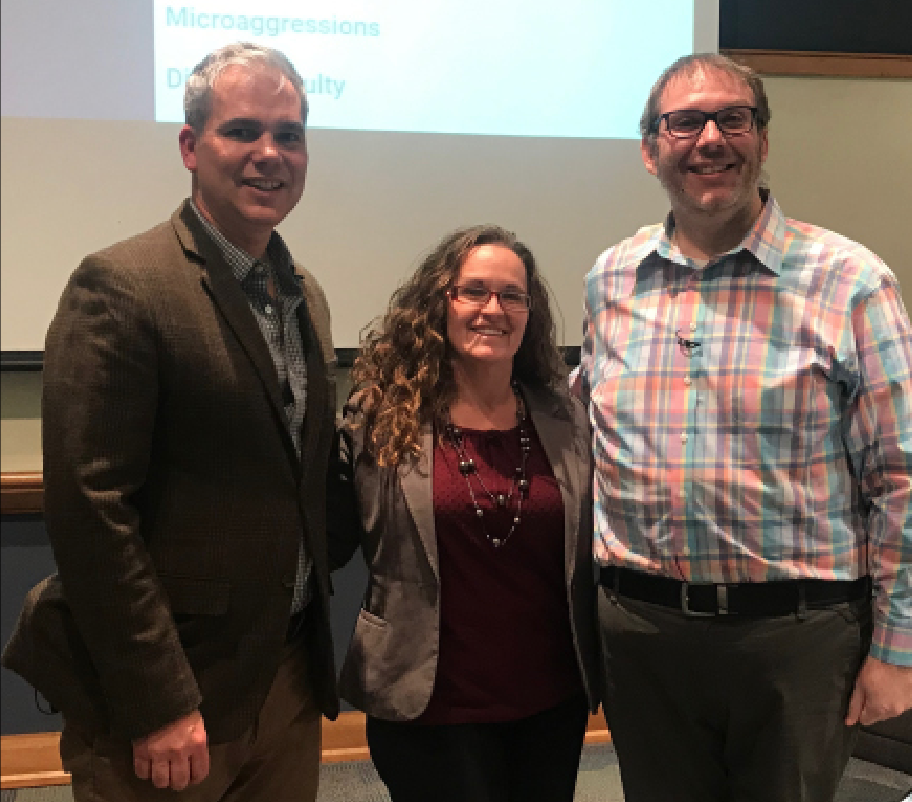
Natalie Irula
Opinion Editor
Three white professors stood at the front of Beers Lecture Hall on Nov. 19 to give a presentation on diversity among professors and students.
Recognizing the irony of the situation, Dr. T. Storm Heter, ESU philosophy professor, Dr. Laura Kieselbach of the English Department and Dr. Gene Kelly, interim dean of students s began the presentation on ESU’s diversity and inclusion efforts with a clarity statement, identifying themselves as “allies, advocates and agents of change.”
The presentation identified ESU as “in a state of transition,” when it comes to racial diversity.
According to Dr. Kieselbach, this means that the faculty and staff are actively recruiting in and networking with organizations representing minority groups, such as the Black Doctoral Network and the Southern Regional Education Board.
Currently, 80 percent of faculty are white and about 43 percent of the first time, full-time students are non-white, according to the Integrated Postsecondary Education Data System. Dr. Kieselbach emphasized the behind-the-scenes changes focused on diversifying staff to reflect student diversity.
As of now, curricular changes have been implemented, a diversity certificate option has been added and student events celebrating diversity have grown along with administrative support for such efforts.
“We need to see and know exclusion before we can start talking about inclusion,” said Dr. Heter, explaining the first step in the process of inclusion. “Equity is fairness. We need to look at who is sitting at the table. Who is participating in the decisions?”
Dr. Heter has begun faculty and staff training sessions he hopes will make a difference in classrooms.
These include workshops sponsored by the Diversity and Inclusion Committee, The Value of Inclusive and Relevant Curriculum meeting and Culturally Responsive Teaching workshops.
“I didn’t recognize what whiteness was until I was about 25,” said Dr. Kelly. “Until that point, I had no conception about the space I take up as a white male.”
Dr. Kelly’s statement was followed by explaining that until recently, “whiteness” was normalized as the default and recognized ESU as a predominately white institution (PWI).
The co-director of The Diversity Project continued by outlining this academic year’s goals toward losing that PWI title.
Those goals include Inclusion and Diversity Pathways, expansion of the Diversity Dialogue Projects, an intentional framework for inclusion and community engagement in social issues, all of which were discussed during the presentation.
Along with diversifying faculty, creating and maintaining a sense of comfort and belonging among students is another one of the university’s priorities.
Using a program called Peardeck to survey students in attendance, students answered “sometimes” questions presented asking whether they felt their values matched those of the university, those of fellow colleagues and whether faculty and staff make every effort to make students feel included.
The presentation also revealed that April 2019’s Climate Survey, surveying over 1,100 individuals, reported 26% of people saying they are “not comfortable” with ESU’s current climate for diversity, equity, and inclusion.
To make students feel more at home, the team plans to put more emphasis on student events and clubs focused on diverse cultures, introducing more interactive art on campus, such as the posters in the union, and spreading the word about the Inclusion Project.
“Coming to programs like this makes students feel more included,” said Dr. Kelly.
Students’ feelings of support on campus go up after attending discussions and non-minority students can understand their roles better.
After the presentation, there was a discussion surrounding student opinions on microaggressions and the want for more multicultural representation.
“I think what we need to hear is student feedback,” said Dr. Cornelia Sewell-Allen, assistant vice president of campus life and inclusive excellence. “What’s happening in the classroom and how we can better support you.”
When asked what else the university is doing recruitment-wise, the team expanded by saying that there are currently 14 faculty positions open, most of which are intended to go towards minority professionals.
However, the issue of diversity does not stop there.
“We know we need to be intentional about recruitment but I always say: What happens when you get here?” said Dr. Sewell-Allen. “How do we welcome them when they get here? Do you know where the barbershop is? Do you know where the salon is? How do we establish mentoring relationships? Do you know where the ethnic-based food market is? Sometimes, that network isn’t there and so that’s what we’re trying to do as a committee.”
ESU’s state of transition is making some progress such as the hiring of new, black faculty members for the next academic year, but there’s still a long way to go.
“There are a lot of people on this campus that are supporting this effort and who are putting in the time,” said Dr. Kieselbach. “People are supporting these changes because we have this foundation of truth from which we are operating and acting on that change.”
Email Natalie at:
nirula@live.esu.edu

